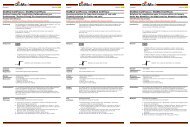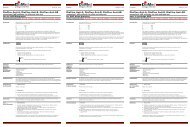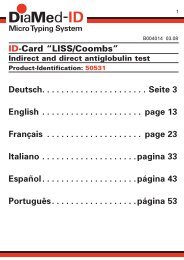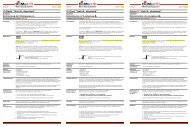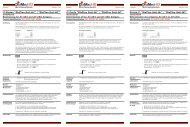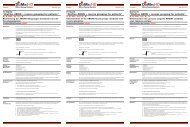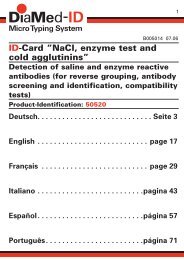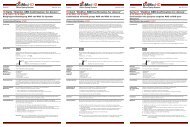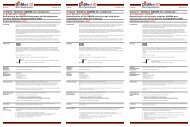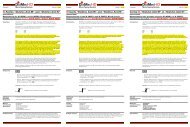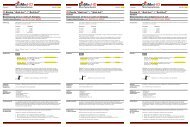Create successful ePaper yourself
Turn your PDF publications into a flip-book with our unique Google optimized e-Paper software.
• Disposable gloves<br />
• Absorbent paper<br />
• Clean plastic containers (either polystyrene or polypropylene) for preparation of Working Conjugate Solutions and<br />
TMB Solution.<br />
• Cell Culture Medium, e.g. RPMI-1640 containing 10% fetal calf serum, equivalent to that used for infected cell<br />
culture (when testing cell culture samples).<br />
(*) Consult us for detailed information about the equipment recommended by our technical department.<br />
5 - HEALTH AND SAFETY INSTRUCTIONS<br />
All the reagents included in the kit are intended for «in vitro» diagnostic use.<br />
• Wear disposable gloves when handling reagents and samples and thoroughly wash your hands after having<br />
handled them.<br />
• Do not pipette by mouth.<br />
• Human source material used in the preparation of the negative control was tested and found non reactive for <strong>HIV</strong>-<br />
1 antigen, anti-<strong>HIV</strong>1 and anti-<strong>HIV</strong>2 antibodies, hepatitis B antigen (HB <strong>Ag</strong>), anti-HCV antibodies, anti HTLV1/HTLV 2<br />
antibodies and anti <strong>HIV</strong>1/<strong>HIV</strong>2.<br />
• The positive control is heat inactivated by dissociating agent.<br />
• Because no known test method can offer complete assurance that the <strong>HIV</strong>, Hepatitis B or C virus or other infectious<br />
agents are absent, consider these reagents, as well as patient samples, as potentially infectious and handle them<br />
carefully.<br />
• Any equipment directly in contact with samples and human source reagents as well as buffer solutions should be<br />
considered as contaminated products and treated accordingly.<br />
• Avoid spilling samples or solutions containing samples.<br />
• Contaminated surfaces should be cleaned 10% diluted bleach. If the contaminating fluid is an acid, the<br />
contaminated surfaces should be first neutralized with sodium bicarbonate, then cleaned with bleach, and dried<br />
with absorbent paper. The material used for cleaning should be discarded into a biohazardous waste container.<br />
• Samples, human source reagents, as well as contaminated material and products should be discarded after<br />
decontamination :<br />
- either by soaking into bleach at a final concentration of 5% sodium hypochlorite (1 volume of bleach per<br />
10 volumes of contaminated fluid or water) for 30 minutes<br />
- or by autoclaving at 121°C for 2 hours minimum.<br />
Autoclaving is the best method to inactivate <strong>HIV</strong> and HBV.<br />
CAUTION : DO NOT PLACE SOLUTIONS CONTAINING SODIUM HYPOCHLORITE IN THE AUTOCLAVE<br />
• The Safety Data Sheet is available upon request.<br />
• Avoid any contact of the substrate buffer, the chromogen and the stopping solution with the skin and mucosa<br />
(toxicity, irritation or burn hazard).<br />
• Do not forget to neutralize and/or autoclave the wash waste solutions or any fluid containing biological samples<br />
before discarding them into the sink.<br />
• Chemicals should be handled and discarded in accordance with Good Laboratory Practices.<br />
• Some reagents contain sodium azide as a preservative. Sodium azide may form copper or lead azides in<br />
laboratory plumbing. Such azides are explosive. To prevent azide built-up, flush the pipes with a large amount of<br />
water if solutions containing azide are discarded into the sink after inactivation.<br />
• Some reagents contain 0.5% ProClin 300<br />
ProClin 300 0.5% : Irritant<br />
R43 : May cause sensitisation by skin contact<br />
S28-37 : After contact with skin, wash immediatly with plenty of soap and water.<br />
Wear suitable gloves.<br />
Xi - Irritant<br />
6 - PRECAUTIONS<br />
The reliability of results depends on correct observance of the following Good Laboratory Practices:<br />
• Do not use expired reagents.<br />
• Do not change the assay procedure.<br />
• Carefully reconstitute reagents avoiding any contamination.<br />
• Do not mix reagents from different lots within a given test run.<br />
7




